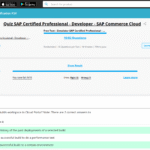Online t-shirt design and sales are becoming famous for expressing your creativity, reaching a broad audience, and making money. Technology and e-commerce platforms allow designers to develop and sell t-shirts without expensive production and distribution. This article will walk you through creating and selling t-shirts online, from ideation through marketing and sales and you can also visit tshirtreviews for better information.
Finding Your Niche
Identify your target audience:
Identify your target demographic before making and selling t-shirts online. Consider age, gender, hobbies, and preferences. Knowing your audience will help you create and sell.
Research popular trends and themes:
Keep up with t-shirt industry fashion trends and topics. Social media, fashion blogs, and internet markets reveal popular styles, patterns, and themes. This study will assist you design for your audience.
Uncover your unique selling point:
Find your USP in the competitive t-shirt market. Find your design’s uniqueness. It might be your art, humour, social or environmental issues, or other unique qualities. Your USP will distinguish you and win customers.
Designing T-Shirts
Choose a design software or platform:
Choose a design program or platform that meets your skill level and needs. Adobe Photoshop, Illustrator, Canva, and Printful and Printify are popular t-shirt design tools. Try several tools and find one that lets you realise your design ideas.
Design ideas:
Brainstorm and draw. Sketch ideas before digitising. Use the topics and trends you investigated and add your flair to your designs.
Convert your design into a digital format:
Digitise your finished design using your design programme. For quality and scalability, choose a vector-based, high-resolution format.
Printing methods:
Consider screen printing, direct-to-garment (DTG) printing, and heat transfer to match your design style, budget, and manufacturing volume. Choose a method based on your needs.
E-commerce Platform Choice
Compare online markets:
Compare Etsy, Shopify, Amazon Merch, and Redbubble for selling t-shirts. Consider platform reputation, reach, usability, integrations, and target audience.
Fees, features, and usability:
Compare listing, transaction, and other platform fees. Analyse analytics, inventory management, marketing tools, and customisable storefronts. The platform’s user-friendliness can also improve your selling process.
Customization and branding:
Compare each platform’s online shop customisation. Personalise shop layouts, domains, and branding components like logos and banners to show off your brand. Aligning the platform’s capabilities with your branding aims will boost brand awareness.
Online Store Setup
Name and brand your store:
Pick a distinctive store name that fits your brand and demographic. Create a professional brand logo. Use online logo creation tools or hire a graphic designer to develop a unique and aesthetically attractive logo.
Write compelling product descriptions:
Write captivating product descriptions for your t-shirts. Highlight your creations’ particular features, materials, dimensions, and detailing. Use compelling words to sell your items.
Capture high-quality product images:
Invest in product photography or pay a professional to take attractive t-shirt photos. Display your works with natural lighting and angles. High-quality photos entice customers and show product quality.
Organise your shop categories:
Make it easier for customers to locate designs by categorising your online store. Organise your t-shirts by themes, collections, or other relevant categories to simplify consumer purchasing.
Printing and Production
Research printing and fulfillment partners:
If you choose conventional printing, choose dependable printing and fulfilment partners. Look for quality-assured, customer-focused organisations. To find a trustworthy and affordable printer, read reviews, request samples, and compare prices.
Consider print-on-demand (POD) services:
These services handle printing, packing, and delivery, reducing inventory investment. Upload your designs to POD platforms like Printful, Printify, or Teespring, and they satisfy orders.
Order sample prints for quality assurance:
Order sample prints to test your ideas before starting your online store or doing big purchases. This guarantees your consumers receive high-quality t-shirts in the colours, sizes, and printing you want.
Pricing Your T-Shirts
Production costs:
Include printing, materials, packing, and other costs when calculating t-shirt costs. Calculate design software, e-commerce platform, and marketing costs. Setting a profitable selling price requires knowing manufacturing costs.
Consider market demand and competition:
Research similar t-shirt prices and demand for your ideas. Price your t-shirts reasonably, but consider brand value and creative designs. Profitability and affordability must be balanced.
Pricing and profit margins:
Set your profit margins and price accordingly. Offer bulk savings or premium limited edition designs. To maximise profit and sales, use alternative price tactics.
Marketing and Promotion
Marketing plan:
Create a detailed marketing plan including your target audience, messaging, and promotional outlets. Create a marketing plan incorporating social media, email, influencer collaborations, content development, and other techniques based on your goals.
Use social media:
Be active on sites that reach your target demographic. To boost brand exposure and online store traffic, publish behind-the-scenes tales, host competitions or giveaways, and work with influencers.
Collaborate with influencers:
Find influencers whose audience matches your target market: request product reviews, sponsored content, or partnerships. Influencers may boost brand reputation and reach.
Special promotions or discounts:
Offer discounts, limited-time specials, or promotions to increase sales. Encourage purchases with hurry and exclusivity. Use social proof to promote these offerings.
Customer Service/Feedback
Excellent client service:
Respond to queries, resolve issues, and provide helpful information for excellent customer service. Make your consumers feel appreciated to encourage repeat purchases and recommendations.
Encourage customer reviews and testimonials:
Customer reviews and testimonials establish trust and social evidence. Show these reviews on your website or social media. Positive comments may sway buyers and boost brand reputation.
Use the input to enhance products:
Use consumer feedback to improve goods and customer experience. Actively solicit design and feature ideas. Customer feedback shows your dedication to quality and satisfaction.
Sales Analysis and Adjustments
Monitor sales and performance metrics:
Analyse sales, conversion rates, and consumer behaviour with your e-commerce platform’s analytics capabilities. Trends, popular styles, and client preferences may inform your design and marketing initiatives.
Analyse consumer behaviour and preferences:
Use demographics, purchase habits, and feedback to understand customers’ preferences. Adjust your product offers and marketing techniques to match their tastes to keep your designs relevant.
Design and advertise accordingly:
Make design and marketing changes based on data and feedback. Retire ineffective designs, try other marketing channels, or improve your messaging. The dynamic t-shirt industry requires constant innovation.
Finally, designing and selling t-shirts online involves strategy, creativity, and perseverance. Follow the steps to succeed. Understand your audience, build attractive designs, pick the best e-commerce platform, give outstanding customer service, and change your strategy based on data and consumer feedback. Your t-shirt business may succeed online with patience and decent items.















